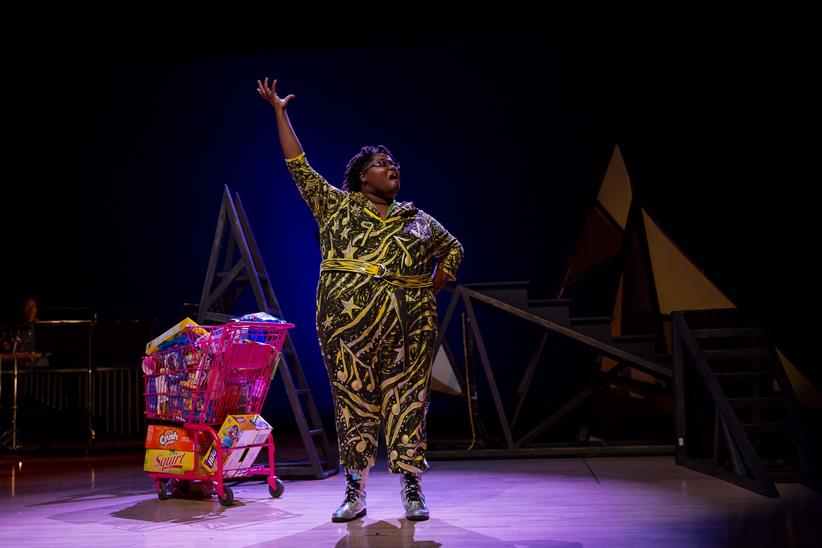Innovating and Ideating

OPERA America’s Innovation Grants program, underwritten by the Ann and Gordon Getty Foundation, supported Professional Company Members in designing and implementing innovative projects in opera’s most important areas of practice. All have had enduring effects that, among other things, allowed companies to incorporate innovative technology, explore new ways of ideating, and establish long-lasting partnerships.
Austin Opera used its first grant to hire a director of audience experience who looked at patrons’ every interaction with the company, “all the way from buying a ticket to when you pull into your driveway after the show,” says General Director and CEO Annie Burridge. Even relatively minor changes — such as arranging for food trucks outside the performance arts center so people who arrived to shows hungry could get something to eat — have left a lasting mark.
“Our long-term audience members appreciate all the enhancements and take advantage of them quite a bit, but even if those were removed, it wouldn’t impact their long-standing behavior of going to the opera,” says Burridge. “For new audiences, this is where looking at the performance experience holistically is really important for retention.”
Attraction and retention of new audiences was a major focus of Austin Opera’s second Innovation Grant, which enabled the company to convene an innovation council and engage the local tech community in conversations about reimagining the opera experience. The first project to come directly from this work was an augmented reality (AR) integration that accompanied a 2020 performance of Everest. When audience members clicked on a QR code on the program cover, a one-minute AR film popped up. “It showed everything that happened on that mountain with all the characters leading up to the first moment of the opera,” says Burridge. “It created this sense of, ‘I can’t wait to see the opera because I can’t wait to see what happens next.’”
The innovation council turned out to be pivotal when the COVID-19 pandemic began. The partners facilitated Austin Opera’s quick transition to digital by providing expertise, access to film studios, and other significant in-kind support.
Burridge sees the work completed with both grants paying dividends well into the future. “Our partnership with the technology community unlocks so many opportunities to connect especially with young people, who are growing up in a digital world,” she says. “It’s totally accurate to say those grants have charted this opera company’s trajectory into the future by helping us embrace the unique qualities of our city — and in endorsing that ideas like AR in opera had value to explore.”
San Diego Opera also leveraged its Innovation Grants to engage with its local tech community through its Opera Hack initiative. A hackathon brings together technology experts and other partners to ideate on problems or challenges in a constrained amount of time. Those who come up with the most widely accepted solutions win money to help them explore their ideas. SDO threw singers, directors, and other opera professionals into the mix with the goal of generating creative solutions to industry-specific problems.
As the company prepares to host its third event later this year, a few ideas developed at past hackathons are already showing real promise. One is a plan to take the cameras real estate companies use to assemble 3D models of homes and utilize them to create virtual renderings of opera houses. “This team is also working with designers to make 3D renderings of sets and lighting that can be digitally ‘placed’ in theaters to see how they will look in the space,” says General Director David Bennett, which will be particularly helpful for companies considering whether to bring in an existing opera production. In addition, it can be used by people developing new productions, who can utilize the program to play with size, lighting, material texture, and other considerations in a 3D environment.
Though Bennett anticipated that most of the proposals would focus on using technology to improve the audience or performer’s experience, “most were for backstage or business practices related to how we produce opera,” he says. “This was partially the result of a series of questions we posted to the industry through OPERA America about what producers and creators saw as challenges that tech could solve.”
Because San Diego Opera does not own any of the intellectual property for ideas formed during the hackathons, creators are free to pursue them for their own benefit. Some are already attracting venture capital, which is bringing a brandnew set of resources to bear on the opera community.
Building off an idea generated at an OPERA America Education Forum, Santa Fe Opera used its Innovation Grant to convene a consortium and commission four new works as part of the “Opera for All Voices” initiative. (Sarasota Opera, Opera Theatre of Saint Louis, San Francisco Opera, Minnesota Opera, Seattle Opera, and Lyric Opera of Kansas City are also partners.)
The consortium started with honest conversations about goals for the new works, what the group could realistically accomplish, and how decision-making could be shared fairly so that large and small companies could have an equal voice. “We wanted to produce works that were more nimble and in service of engaging new or younger audiences — the opera-curious,” says Santa Fe Opera Director of Community Engagement Andrea Fellows Fineberg. Innovating around civic practice was also a consideration: “We wanted to move beyond the traditional approaches to opera in the schools and think about what opera in the community really was.”
To date, the consortium’s commissions are Sweet Potato Kicks the Sun by composer Augusta Reed Thomas and librettist Leslie Dunton- Downer and Hometown to the World by composer Laura Kaminsky and librettist Kimberly Reed. Both demonstrated that “there is an appetite and desire for stories that have a social justice component and/or center women,” Fineberg says.
The third opera to come from the consortium will be This Little Light of Mine by composer Chandler Carter and librettist Diana Solomon- Glover, which tells the story of voting rights advocate Fannie Lou Hamer. The fourth is likely to be the work of an Indigenous team of artists.
Santa Fe Opera will shift its whole business model as a result of this work, focusing more on co-production as well as co-commissioning. The company and its partners are also deepening their connection and collaboration with music schools. “We were able to have an orchestral workshop at Arizona State University for Hometown to the World, and they funded it,” Fineberg says. “Universities and conservatories are really interested in these smaller works that speak to the world as we see it around us. They also appreciate the opportunity to work with living artists and help students hone their crafts.
“When students have an opportunity to be part of the development of work, you get this incredible new vibrancy,” she adds. That’s an important consideration since these young people are part of the “opera-curious” generation companies wish to engage.
OPERA America extends its deepest gratitude to the Ann and Gordon Getty Foundation for supporting these and other transformative changes at American opera companies.
This article was published in the Spring 2022 issue of Opera America Magazine.

Sophia Bennett
Sophia Bennett is the editor of Opera America Magazine.




